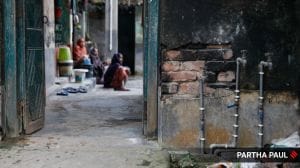Mumbai’s air quality plummets ahead of Diwali, 9 locations record ‘poor’ and ‘very poor’ AQI
Experts attribute poor air quality in Mumbai to increased firecracker usage during the Diwali festivities and ongoing construction activities.
 With Diwali around the corner, citizens have been bursting firecrackers throughout the entire weekend. (Express Photo by Amit Chakravarty)
With Diwali around the corner, citizens have been bursting firecrackers throughout the entire weekend. (Express Photo by Amit Chakravarty)Mumbai’s overall Air Quality Index (AQI) plummeted severely Monday morning on the day of Diwali. The city recorded an AQI reading of 187, which is the worst recorded since the monsoon withdrawal on October 10.
While the overall reading lingered around the ‘moderate’ category, the Central Pollution Control Board’s (CPCB) data shows that nine out of the 24 different AQI monitoring stations operational in Mumbai recorded ‘poor’ and ‘very poor’ AQI.
According to the CPCB dashboard, Bandra Kurla Complex (BKC) recorded an AQI reading of 334, followed by 274 at Colaba (Navy Nagar), 268 at Deonar, 264 at Vile Parle, 257 at Andheri East, 240 at Mazgaon, 238 at Bandra East (Kherwadi), 214 at Malad and 201 at Worli.
AQI readings of 0-50 are classified as ‘good’, 51-100 as ‘satisfactory’, 101-200 as ‘moderate’, 201-300 as ‘poor’, 301-400 as ‘very poor’, and above 400 as ‘severe’.
With Diwali around the corner, citizens have been bursting firecrackers throughout the entire weekend. Usually, Mumbai records a rise in the overall AQI following Diwali every year, owing to the cracker-bursting activities as well as the settling in of the winter conditions.
Further dip in air quality likely
Meanwhile, weather experts and meteorologists have maintained that Mumbai’s AQI may worsen further in the coming months owing to the La-Niña condition, which is a climate pattern characterised by the cooling of surface-ocean waters in the equatorial Pacific Ocean.
During La Niña, changes in atmospheric circulation result in reduced wind speeds, which prevent pollutants from dispersing quickly and cause them to linger longer in the air, particularly in coastal cities like Mumbai.
Speaking to The Indian Express, Gufran Beig, chair professor of National Institute of Atmospheric Sciences (NIAS), said, “La-Niña usually slows down the overall wind speed, which forces the AQI to go down. This phenomenon was earlier seen during the 2021-2022 period, which had resulted in a serious dip in Mumbai’s air quality.”
“This condition may get worse since during November, the wind speed is likely to slow down. Furthermore, activities like cracker bursting during Diwali may also contribute to the AQI going down.”
Meanwhile, the authorities have maintained that monitoring stations have started to record poor air quality owing to the bursting of firecrackers.
“Some of the areas, like BKC, have been recording consistently poor AQI readings. This can be attributed to two factors: one, there is construction going on for infrastructure projects like the bullet train, and two, this place records a heavy traffic influx that leads to dust displacement, which causes the air quality to go down. Also, since last Friday, the number of crackers bursting in Mumbai has risen, which is also contributing to Mumbai’s AQI,” an official said.
“We have already asked the builders and contractors involved in real estate projects to start sprinkling water at their premises to prevent dust displacement. At present, monitoring is underway, and on-ground action will be taken up soon,” the official added.







